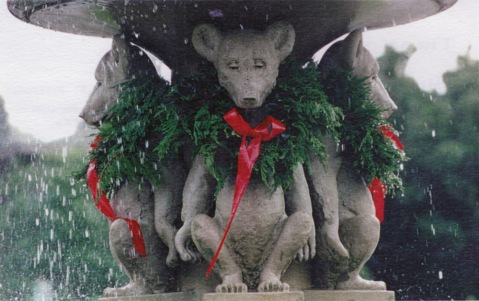Boston gets another Caillebotte
September 28, 2011 § Leave a comment

Man at His Bath | Gustave Caillebotte
Man at His Bath was painted in 1884 by Caillebotte, who was known for his scenes of urban life on the grand new boulevards of Paris. Favorites include Paris Street, Rainy Day (1877, Art Institute of Chicago) and the Floor Scrapers (1875, Musée d’Orsay).
Born into a wealthy family, Caillebotte sold few of his paintings. Instead, he bought work by his friends, including Cézanne, Degas, Manet, Monet, Pissarro, Renoir and Sisley. When he died in 1894 at the age of 45, Caillebotte left the best of his collection to the French state. Today they hang at the recently renovated Musée d’Orsay in Paris.
Man at His Bath, measuring approximately 6 x 4 ½ feet, traveled to Brussels in 1888 to be exhibited by the vanguard organization Les XX (“The Twenty”). But it appears to have been removed from the general exhibition and shown privately only to a few visitors. It passed to the artist’s family in Paris. In 1967 it was acquired by a private collection, which recently sold it to the MFA. Man at His Bath is the second Caillebotte painting to enter the collection in Boston, joining Fruit Displayed on a Stand (circa 1882).
To purchase Man at His Bath, the MFA is deaccessioning eight late 19th century works:
• View from the Artist’s Window, Eragny, 1885, Camille Pissarro
• Overcast Day at Saint-Mammès, about 1880, Alfred Sisley
• Gust of Wind, 1899, Maxime Camille Louis Maufra
• Forest Interior (Sous-Bois), 1884, Paul Gauguin
• The Fort of Antibes, 1888, Claude Monet
• Bust Portrait of a Young Woman, about 1890, Pierre-Auguste Renoir
• Saint-Mammès: Morning (Le Matin), 1881, Alfred Sisley
• Pearl Mosque, Delhi, late 1880s, Vasily Vereshchagin
EARLIER: “How the ‘Floor Scrapers’ found a home”
How the ‘Floor Scrapers’ found a home
June 23, 2010 § Leave a comment

Floor Scrapers | Gustave Caillebotte | Musee d'Orsay
One of just about everybody’s favorite paintings — “Floor Scrapers” by Gustave Caillebotte — is visiting for a few months as part of the “Birth of Impressionism” exhibition at the de Young Museum — a blockbuster loan from the Musee d’Orsay in Paris, which is undergoing renovation.
It comes with a great story.
Caillebotte was a talented painter. He was also from a wealthy family. That enabled him to encourage his fellow Impressionists, long before their work found favor, by buying their paintings. He assembled a remarkable collection of work by his friends: Manet, Monet, Renoir, Pissarro, Sisley, Degas and Cezanne. When Caillebotte died in 1894 he left about 60 paintings from his collection to the French government. But Impressionism was still a marginal movement, and the authorities were reluctant to accept the bequest.
With the involvement of Renoir and Monet, an agreement was eventually reached and 40 paintings from Caillebotte’s collection were exhibited in a new wing of the Musee du Luxembourg. Among them are many of the jewels of French Impressionism. That includes Caillebotte’s own “Floor Scrapers,” which, at Renoir’s insistence, was added to the bequest.
New exhibition: “The Caillebotte Brothers’ Private World“
Lawyers turned artists
February 12, 1996 § Leave a comment

By REYNOLDS HOLDING
San Francisco Chronicle
It’s a common curse of being a lawyer: the nagging urge to be something else. Though most ignore it, many succumb, often by trying to become the next John Grisham.
But four former Bay Area attorneys are taking a different tack. They’ve become artists, and they’re showing their work at San Francisco’s Thomas Reynolds Gallery — and Reynolds, it turns out, is also a recovering lawyer.
Here’s the surprising news: All four artists are really good.
Not that they weren’t good lawyers, too. Mary Dunlap was one of San Francisco’s most prominent civil rights attorneys. But in 1991, after finishing a high-profile discrimination case against the San Francisco Fire Department, she was exhausted. “I was a workaholic,” she says, “and it got to the point where I needed to do other things that had really been neglected.” She’s still a legal consultant on public interest cases, but most of her time is spent creating colorful monoprints of birds and fish and self-portraits.
Her colleague, Sarita Camille Waite, practiced family law in Berkeley for 17 years until 1987, when she turned to sculpture. Much of her work is small bronze figures, but she’s working now on a fountain for Marin Circle in North Berkeley.
A third artist, Jerome Carlin, founded the San Francisco Neighborhood Legal Assistance Foundation in 1966. But for the past 25 years, he has painted California landscapes, some of which hang in New York’s Metropolitan Museum of Art and the Art Institute of Chicago.
The fourth in the group is Jody Joseph, former head of the San Francisco Bar Association’s legal services program. Now she paints portraits, landscapes and still lifes in a cubist style.
All but Carlin say they loved practicing law, but for various reasons had to get out. “I had no alternative,” says Joseph. “Otherwise it would have been a half-lived life.”
She’s in good company. Reynolds says a lot of famous artists left the law, including the French post-Impressionist master Paul Cezanne. What made him make the move? Maybe it was the advice from his friend, novelist Emile Zola: “One thing or the other — really be a lawyer, or else be an artist, but do not remain a creature without a name, wearing a toga dirtied by paint.”
Read more: Jerome Carlin: The two sides of my brain

